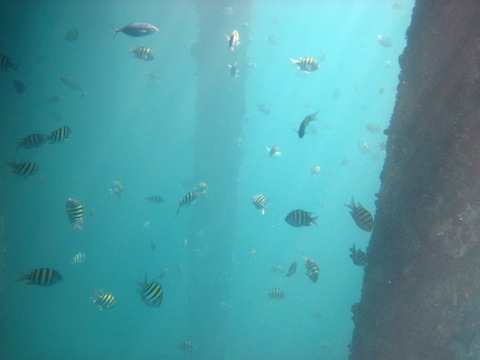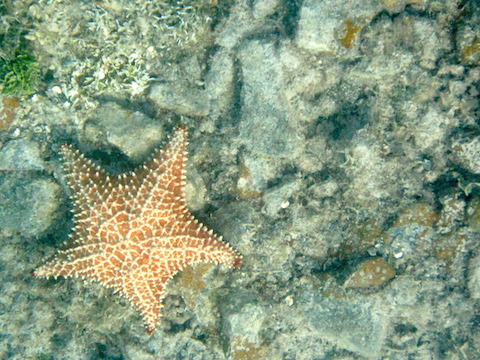Vieques is a small island
off the east coast of Puerto Rico, close to the Virgin Islands.
We chose this location for our traditional January trip over
St. John in the Virgin Islands because our favorite place to stay
on St. John had closed.
We paddled a kayak on the bioluminescent bay under a sky filled with bright stars.
We snorkeled at four different places, seeing lots of fish, coral, and a pair of squid.
We hiked on trails up hills and down to beaches, including a beach with black sand.
It was warm, very comfortable and relaxing.
|
Our adventure began at 3 A.M. January 14 with
a text from United Airlines telling us that the first
leg of our journey was delayed by an hour. This was a problem
because we only had one hour in Newark to catch the second leg
of our trip.
When we got to BWI an hour later, we found that United had re-booked us
on American to Miami and then on to San Juan.
At the American counter, we found that United had
failed to tell American of our final leg from San Juan
to Vieques via Cape Air.
Therefore, American would only check the suitcase containing our snorkeling
gear through to San Juan.
This caused us some anxiety because with very little time, we would
have to get our suitcase off the carrousel in San Juan and run it
over to the Cape Air desk to re-check it.
When we arrived in San Juan, Gail headed for Cape Air to get our seats while
Al went to the baggage carrousel.
Our bag came quickly, but Al did not get to Cape Air in time.
Fortunately, the Cape Air staff were able to get him and our snorkeling
gear on a flight 2 hours later, so we were able to spend the
first night of our vacation at our destination together.
United Airlines had mixed up our travel plans before. We made our
reservations in September. Then in mid October the Cape Air flight
we were scheduled on was cancelled.
When that happened, United moved us to
a substitute flight that left San Juan three
hours before our connecting flight arrived.
Just a little error in the scheduling algorithm!
|

|
The following day was a highpoint: we took a nighttime tour to
Puerto Mosquito, Vieques's
bioluminescent bay.
When we paddled
out in kayaks, the water glowed from the dinoflagellates each time we
dipped the paddle or our hand into the water. Even a passing fish
would leave a luminous wake in the water. We could see
faint pin-points of light where the dinoflagellates flashed spontaneously.
We did not capture any of this with our cameras so you'll just have to
trust our memories.
A bonus from the dark sky required for the bioluminescent bay was that
the stars from Cassiopeia in the north to Canopus
in the south stood out brightly. Orion and Canis Major were
spectacular nearly overhead.
It was a magical evening.
While we were on the island, we stayed in the upper level of the Pink House,
a Vacation Rental By Owner (VRBO.com) in the village of Esperanza on
the south shore of Vieques.
It was comfortable and had everything we needed for our stay, even WiFi.
The Pink House is far enough from the Malecon that noise there did not disturb us,
yet we could walk anywhere we wanted in town. On the map, Esperanza's streets had
names, but there were no street signs. There weren't even any Pare (stop) signs, except at
the intersections with the highways. Drive with caution.
|
The Pink House
|
The Malecon in the village of Esperanza.
The sea is just off to the left, restaurants to the right.
|
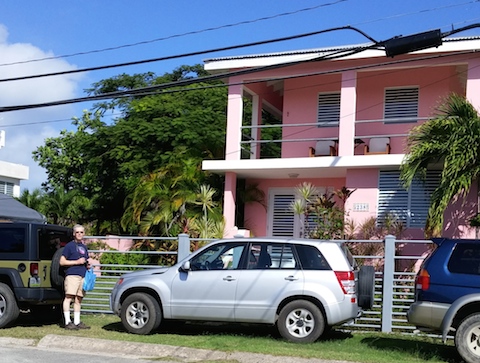
|
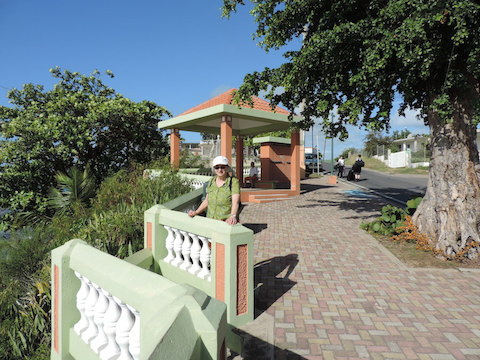
|
Gail had a sore throat and didn't feel like snorkeling for a couple of days,
so we did a little hiking instead.
One day we went to Cayo de Tierra, a little almost island that helps form
the bay at Esperanza. Another time we walked the Vereda Cerro Playuela trails in the
National Wildlife Refuge.
Hiking on Esperanza Beach, one of many beautiful beaches on Vieques,
to explore the trails on Cayo de Tierra in the right background.
|
Caracas Bay seen from an overlook
on the Vereda Cerro Playuela trail
|
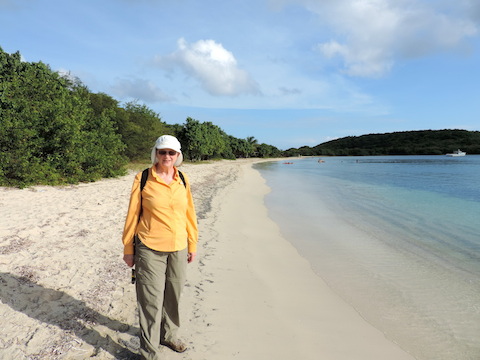
|
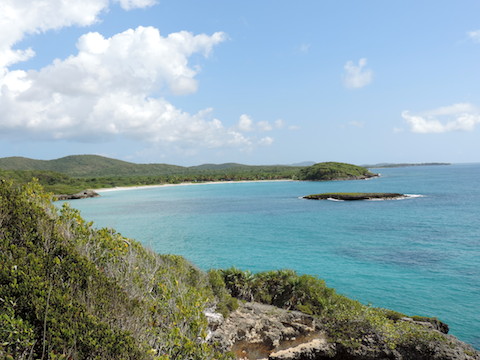
|
Eventually we did get back into the water, visiting La Chiva (called Blue Beach by the
U.S. Navy when they used the island as a bomb range), Caracas (called Red Beach by
the Navy), and Pata Prieta (Secret Beach).
|
A juvenile Beaugregory in Bahia de la Chiva
|
A Sanddiver in Bahia de la Chiva
|
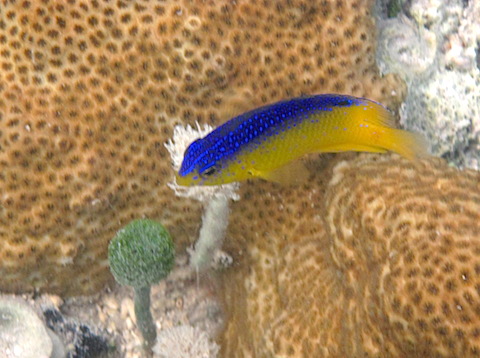
|

|
A squid amidst the coral at Caracas Beach
|
A garden of brain coral and Venus sea fan coral at Pata Prieta
|

|
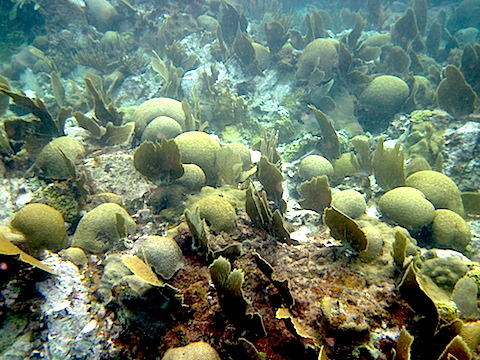
|
A Blackbar Soldierfish at Pata Prieta
|
Relaxing on the beach after snorkeling at Pata Prieta
|
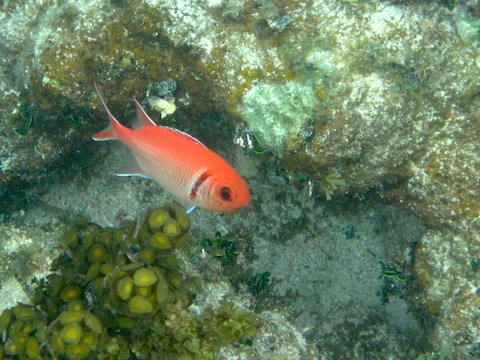
|

|
Horses descended from those brought by the Spanish colonizers
roam freely on the roads, streets, fields, and, yes, on the beaches.
Watch where you step.
Other animals also wander freely: dogs, chickens, cats.
It is hard to know whether they belong to someone or whether they
are strays.
|
One of the roaming horses
|
Playa Negra, the black sand beach on Vieques
|

|
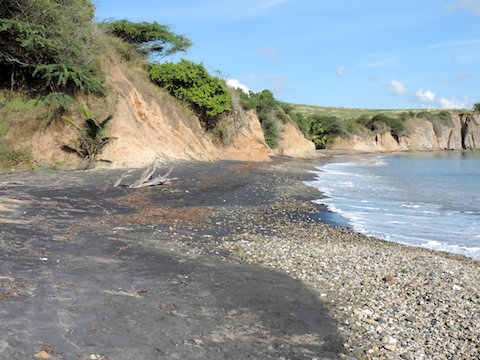
|
One of the pleasures of visiting a distant place is sampling the
local dishes. We cooked many of our meals at the Pink House to
economize, but we did eat at three Vieques restaurants: Duffy's, Bananas,
and Conuco. Our favorite dishes were the fish tacos at Duffy's and the
mofongo at Bananas.
We arrived on a Wednesday and flew home the following Wednesday,
bringing good memories and lots of photos, but leaving behind
beaches unvisited, attractions unseen, and dishes unsampled.
|
Dining on mofongo in the Restaurante Conuco in Isabel Segunda
|
Faro de Vieques, the 1896 lighthouse in Isabel Segunda
|

|

|
Created: 26 Jan 2015; updated: 29 January 2015

